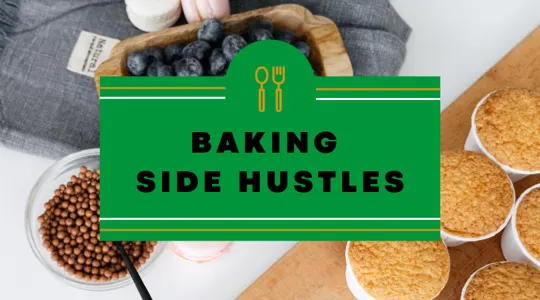
You’re a baker at heart and want to know how to earn money from it. You can make baking a side hustle. All it takes is a little hard work and organization. There are several steps to following your baking dreams and making baking a side hustle.
How to Start a Baking Side Hustle
To start a baking side hustle, develop a business plan, comply with state and local laws for home bakeries, set up a business entity, obtain necessary licenses and insurance, organize finances prepare for taxes create a menu, and price your products appropriately.
Key Takeaways
-
Develop a business plan, including a mission statement, business name, target market, and financials.
-
Check state and local laws regarding home bakery operations, licensing, and taxes.
-
Set up a business entity, and obtain necessary licenses and insurance.
-
Organize finances, separate business and personal accounts, and prepare for tax obligations.
-
Create a menu, and price your products considering ingredients, labor, and overhead costs.
-
Market your business through social media, packaging, and word-of-mouth.
If you still want to know, continue reading and you’ll get to know everything starting your baking side hustle easily.
I have also shared side hustle ideas for accountants, teenagers, and for therapists on this site. Do check them If you haven't already.
Can You Sell Food Out of Your Kitchen?
Image source: deliverect.com
You can sell food out of your kitchen in a limited number of states. Some states, like Florida, will let you sell food without a license or permit. But many states, like Florida, allow this and have a cap on sales. Generally, you'll need to check with your state and local government.
If you're continually receiving compliments on your cakes and cookies, consider selling them. A baking side hustle can be a fun way to earn a second income. We've put together several steps and ideas on how you can make money baking.
Develop a Business Plan
Image source: Forbes.com
You would think that with a side hustle, you don't need a business plan. After all, you're not investing a lot or going to investors. But without a business plan, your banking side hustle could fail fast. This is the serious side of your business.
Think of a business plan as a road map.
There are many essential elements to a business plan. Some you should include:
- Mission statement – describe your business in a statement. What items will you offer and what makes your bakery unique?
- Business name – people love catchy business names but it needs to be clear as to what you’re selling. Don’t get too cute. Check to see if you’re name is available.
- Define target market – do you want to sell to the specific sections of the general public or to weddings? There’s a lot of competition out there, find a target market that’s underserved.
- Financials - pricing, expenses, and profit.
With a side hustle, your business plan will be simple but effective. It will show you what investment you need to make and possible expenses. Pretty much most items in this article should be incorporated into a business plan.
With side hustles, you also don’t have to look for jobs on Geebo, and install the so-called make-money apps such as Mistplay or Rewarded Play.
Check Home Bakery Laws
Image source: Indeed.com
This is a business, so it's subject to state and local laws regarding food. You'll also need to know about baking business licensing and taxes.
Even though it’s a side hustle, you’ll still need to pay taxes.
Cottage Food Laws
There are three types of bakeries. They are:
- Home bakeries
- Commercial bakeries
- Retail bakeries
Commercial and retail bakeries have designated storefronts or production kitchens. Commercial bakeries must meet certain sanitation and equipment requirements.
Cottage food laws are sections of the law that cover home bakeries. They are regulated on a state-by-state basis. Cottage laws are limited to shelf-stable food. They can’t require refrigeration. Bakeries are acceptable.
Sales Limits and Target Market Limits
Image source: Salesforce.com
Usually, cottage bakeries have limited sales. This is to prevent the home-based business from becoming too large. They want to keep you from being a retail or commercial bakery business. You’ll need a commercial building for that.
Cottage bakery laws have rules regarding who you can sell to. They are usually direct-to-consumer sales only. You can’t sell to local bakeries or grocery stores.
But every state has different laws. Check with your state and local health departments; they will provide information.
Create a Business Entity and Check on Licenses
Image source: cwmpk.com
Depending on your state, you may need a state business license. You also might need a city business license. You may need a food manager license from the health department and state.
Set up a business entity like a limited liability company (LLC). An LLC will protect your personal assets from legal liability or lawsuits. An individual or sole proprietor won't protect you.
You may also need insurance.
For those who may have missed my post Why is Personal Finance Dependent on Your Behavior it’ll give you a great idea about starting your business and how you need to act with your money.
Insurance
Image source: thebalancemoney.com
Although you may think your homeowner's insurance will cover your business, this usually isn't the case. Homeowners insurance has a business exclusion. This means a claim against you wouldn't be covered for your home baking business.
That means if your equipment is damaged by a storm or someone slips in your kitchen when they come to pick up cupcakes, you’re liable.
A customer slip and fall could cost you between $10,000 and $50,000. And if your equipment is stolen, the average burglary and theft loss is $2,416. So, there could be significant financial repercussions.
The bottom line is your homeowner's policy isn’t going to help you in your homemade food business.
Organizing Finances and Paying Taxes
Image source: kuapay.com
You must charge sales or food tax on the items you sell. If you don't, you'll have to pay them out of your pocket. Carefully track your sales and document their breakdown so you won’t pay too little or too much tax.
It’s wise to set up a quarterly tax payment to the IRS to keep you up to date.
It’s imperative to organize your finances by setting up a separate bank account for your business. This can be done after you’ve legally created your company.
Mixing your business income and taxes with your personal account is a disaster waiting to happen. It’s almost impossible to track company revenues and tax liability.
Consider investing in bookkeeping software like QuickBooks or using a Microsoft Excel spreadsheet.
Create the Menu
Image source: wepik.com
Now that you know the serious side of the business, it’s time to start the fun side: baking. First, you’ll need to decide what you want to bake.
You can choose from:
- Cupcakes.
- Cookies.
- Bread.
- Muffins.
- Cakes.
Or you can make all of them. But it’s best to stick with two or three items. You should start with your specialties and then later expand when you’re ready.
Remember, this is supposed to be fun too. So, don’t bake anything you don’t enjoy.
Recipes and Pricing Baked Goods
Have the recipes you want to use in order. Remember, you'll probably be making bigger batches than what they call for, so you must adjust them accordingly.
Once you have your menu organized, you'll need to price your goods. This is the nitty-gritty of your profit. Don't just look at what the competitors charge.
The price of your baked goods should cover:
- Cost of ingredients.
- Labor overhead (business fees, insurance, farmer’s market fees, equipment fees, etc.).
- Profit.
Figuring out all these numbers can be challenging and not much fun, but it needs to be done if you want to make a go of this business.
When figuring out the cost of ingredients, build a spreadsheet of each ingredient you use. You'll also want to add the cost in common units. These are the measured ingredients that go into the recipe.
Start with the ingredients like:
- A pound of flour.
- A dozen eggs.
- A pound of butter.
- A carton of salt.
- Bottle of vanilla or other flavoring.
- A pound of sugar.
You'll need to figure out how you're going to increase the amount of your recipe to do this. But once you have figured you must figure out each ingredient and measure each item, like:
- How much is a cup worth in each recipe?
- How much is a pound of butter worth in each recipe?
- How much is a teaspoon of vanilla worth in each recipe?
For example, if a dozen eggs cost six dollars and you use four in a recipe, your egg cost is $1,50. Figure that out for each recipe. Remember, prices can increase or decrease, so adjust accordingly.
When figuring the cost of a single item like a cupcake, you do the math similarly.
Suppose the price of a batch of cookies is six dollars, and you make 24 cookies. Your cost per cookie would be six dollars divided by 24, which is equal to $0.25 per cookie.
But it doesn’t stop there. You can’t just charge your local customers the cost of ingredients.
Labor and Overhead Costs
How much do you want to be paid? Figure out how many hours it takes you to make that batch of cookies, and then pay yourself.
Do you want to make $25 per hour, or can you get by on $15? Only you can decide what you’re worth.
You also need to prorate and add in your overhead costs. Some of these are:
- Insurance
- Electricity
- Marketing
Calculate your total monthly overhead and estimate how many cookies you think you’ll make. Then, divide the cost by the number of cookies and add it to each cookie.
Organize the Kitchen
Decide what equipment you’ll need. You’ll need to budget for equipment expenses. Do you need a new oven or mixer? These can add up fast and might need to be factored into the price of goods, at least until you pay for them.
Marketing Your Business
Once you have your business plan and everything priced out, you’ll need to think about marketing. Marketing is simply telling people about your business. This is vital to your business.
You need to make people aware of you, or no one will buy your baked goods. And although you want word of mouth, that may not be enough.
Social media is a great place to start. You can start a Facebook page specifically for your business.
Keep it separate from your personal Facebook page so it looks more professional. Once you’ve established yourself, start advertising your business on Facebook by buying ads.
Create posts on Instagram. It’s a natural place to show off your style and creativity. This is especially true if you’re baking decorated wedding cakes or fancy cookies.
When you sell baked goods, be sure to have a card in the packaging that advertises your business. For example, a business card with the following:
- Name of business
- Phone number
- Social media
- Menu
This can go a long way to growing your business. For example, someone may gift a cake to a friend. That friend now has your contact information and can order from you.
The best part about starting a baking side hustle is, that you can do that while homeschooling or similar other stuff with little to no money.
Baked Goods Transportation
Whether to deliver or not to deliver, is an important question. If you advertise you’ll deliver, you’ll need to have transportation that can accommodate a large cake (if that’s what you’re into) or how do you deliver cupcakes without ruining them?
And remember, if you’re out delivering baked goods, it will keep you away from the kitchen.
However, offering a delivery service may attract more customers.
Some homebakers insist that the goods be picked up. But then you risk someone falling on your property.
Weigh the pros and cons and do what you feel the most comfortable with.
Frequently Asked Questions
You now have the steps to start a baking side hustle. It may seem complicated but once you do the prep work all you need to really do is bake. But in case you have other questions, we have the answers.
1. Are farmers' markets a good place to sell my baked goods?
Farmer’s markets are a great place to sell baked goods. You’ll need to rent a booth so add that to the cost of your goods. You also must check to see if your farmer’s market has any requirements for selling food.
Think about how you’ll transport your baked goods; especially the cupcakes.
2. Do I need special insurance for a home bakery?
You need business insurance for a home bakery business. Homeowners' policies have business exclusions. You cannot run a business in your home and expect the insurance company to cover any losses like slips and falls and theft.
Talk to your insurance agent about buying the right insurance.
3. Should a baking side hustle have a Facebook page?
A baking side hustle should have a Facebook page. If you are doing farmers' markets, you can advertise where you will be. It's also a great opportunity to show your product. If you have a business phone, you can post it on Facebook so people can contact you.
A Baking Side Hustle is Doable
Although it takes a little prep work, having a baking side hustle can be both fun and a money maker that let's you save money for an emergency purpose. Start small and then expand later. Use friends and family at first to get the word out to people.
Social media is your friend when it comes to marketing your goods. But ensure you have your baked goods priced so you can make a profit.
Don't try to be all things to all people. Start with a specialty, and when that takes off, add other goodies.



